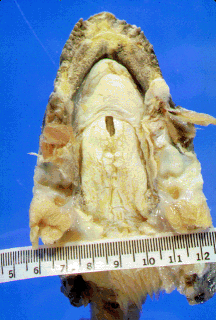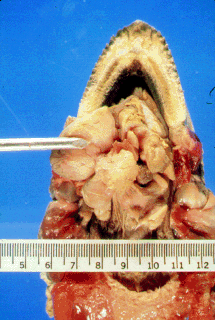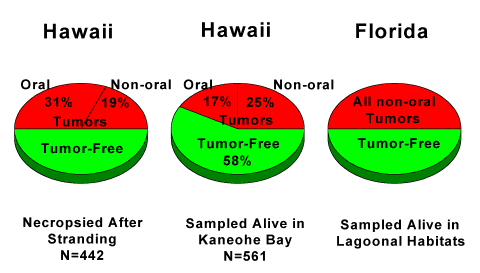
Recent analysis of data for the Hawaiian population indicates that fibropapillomas commonly occur in the oral cavity and adjacent tissues.
Examples of oral tumors afflicting Hawaiian green turtles.

George H. Balazs1, A. Alonso Aguirre2, and Shawn K. K. Murakawa2
| 1National Marine Fisheries Service, Southwest Fisheries Science Center, Honolulu Laboratory, 2570 Dole Street, Honolulu, Hawaii 96822-2396, USA |
| 2Joint Institute for Marine and Atmospheric Research, 2570 Dole Street, Honolulu, Hawaii 96822-2396, USA |
Fibropapillomatosis (FP) is a tumor-forming transmissible sea turtle disease of relatively recent significance that globally affects mainly green turtles (Chelonia mydas). The disease has been most prominent in the Hawaiian Islands and Florida (USA) where half or more of the immature green turtles in some coastal foraging pastures are affected. The cause of FP is unknown; however, a herpes virus (Herbst, 1994; Herbst et al., 1995) and a retrovirus (Casey et al., 1996) have been implicated as possible etiologic agents. The mode of transmission and why the disease has become epidemic in some populations also remain to be determined. The usual outcome for most affected turtles in Hawaii is debilitation over a protracted period, followed by death.
In both Hawaii and Florida, where FP has been the focus of most studies to date, multiple fibropapillomas ranging in diameter from a few millimeters to 25 cm can occur on all skin surfaces of an animal. The most common sites of affliction are the axillary region of the flippers, and on the eyes, neck, and tail. Other sites affected less frequently include the carapace, plastron, and internal organs. The formation of tumors in the ocular region, causing partial or total loss of vision, has been well documented in both populations.

| Recent analysis of data for the Hawaiian population indicates that fibropapillomas commonly occur in the oral cavity and adjacent tissues. Examples of oral tumors afflicting Hawaiian green turtles. | 
|
Differences have not been previously reported between green turtles in Hawaii and Florida in the expression of FP relating to the anatomic sites affected. Recent analysis of data for the Hawaiian population indicates that fibropapillomas commonly occur in the oral cavity and adjacent tissues. Between 1991-1995, 442 dead or moribund green turtles found stranded throughout Hawaii were examined and necropsied. Turtles with FP comprised 50% (n=222) and, of those, 61% (n=136) had oral fibropapillomas, ranging from mild to severe involvement. The size, site, and locally invasive nature of many of these growths indicated that normal breathing and feeding ability had been impaired, thereby contributing to stranding and death. In a separate study, also between 1991-1995, 561 green turtles were captured alive, examined, and released within Kaneohe Bay in Oahu, Hawaii. Turtles with FP made up 42% (n=236) and, of those, 40% (n=94) had oral tumors.
In contrast, virtually no tumors of the oral cavity have been found among green turtles studied in Florida as the result of strandings and live capture of free-ranging individuals (L. M. Ehrhart, University of Central Florida; B. A. Schroeder, Florida State Department of Environmental Protection; E. R. Jacobson, University of Florida; W. G. Teas, U. S. National Marine Fisheries Service, personal communications).

No demonstrable explanation currently exists to account for this notable difference in the expression of FP. Routes of exposure for the disease at various anatomic sites may not be equivalent between turtles living in Hawaii and those living in Florida. One possible significant difference may be greater numbers of ectoparasites, such as ozobranchus leeches and talitroidean amphipods in the mouths of Hawaiian green turtles. Small lesions to oral tissues caused by these organisms may serve to promote infection by the agent responsible for FP.
The impact of FP to individual turtles needs to be better characterized for each population in order to adequately understand the etiology of this serious disease. The predilection for oral tumors in the Hawaiian population, as summarized here, may provide useful clues for conducting additional research.
Casey, R. N., S. L., Quackenbush, T. M. Work, G. H. Balazs, P. R. Bowser, and J. W. Casey. 1996. Identification of retroviruses associated with unaffected green sea turtles and turtles with fibropapillomas. [Abstr.] AQUAVET 20th Anniversary Conference, 14-17 November 1996.
Herbst, L. H. 1994. Fibropapillomatosis of marine turtles. Ann. Rev. Fish Dis. 4:389-425.
Herbst, L. H., E. R. Jacobson, R. Moretti, T. Brown, J. P. Sundberg, and P. A. Klein. 1995. Experimental transmission of green turtle fibropapillomatosis using cell-free tumor extracts. Dis. Aquat. Org. 22:1-12.